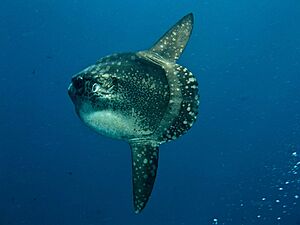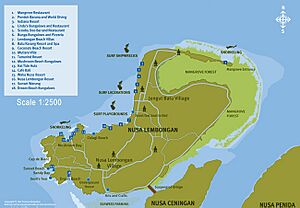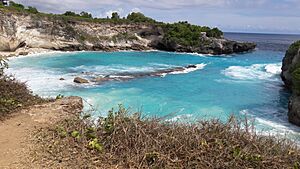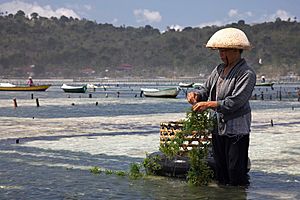Nusa Lembongan facts for kids
Nusa Lembongan is a small island located southeast of Bali, Indonesia. It's one of three islands often called the "Nusa Islands," along with Nusa Penida and Nusa Ceningan. Nusa Lembongan is the most popular of these islands for visitors. These islands are part of a larger group called the Lesser Sunda Islands.

Where is Nusa Lembongan?
Nusa Lembongan is about 8 square kilometers in size and has around 5,000 people living there all the time. It's separated from Bali Island by about 12 kilometers of water called the Badung Strait.
The island is surrounded by amazing coral reefs, white sand beaches, and low limestone cliffs. A shallow channel separates Nusa Lembongan from Nusa Ceningan. There's a special suspension bridge that connects Nusa Lembongan and Nusa Ceningan, but only people walking or riding motorbikes can use it.
There are three main villages on Nusa Lembongan. Jungut Batu and Mushroom Bay are where most of the tourist activities happen. Many local people live in Lembongan Village.
Getting to the Island
You can get to Nusa Lembongan easily by speed-boat from Sanur, a town on Bali's east coast. The boat ride takes about 30 minutes. Bigger cargo boats also travel daily from Padang Bai, another port town in Bali.
Once you're on the island, most people get around by scooter or on foot. There are very few cars because the island is quite small.
What Do People Do Here?
The main way people make a living on Nusa Lembongan is through tourism. It's the most developed of the Nusa Islands for visitors, offering many places to stay and eat.
Nusa Lembongan is famous for its excellent surfing spots, like Shipwrecks, Lacerations, and Playgrounds. It's also a fantastic place for scuba diving and snorkeling to see the colorful coral reefs.
For a while, people also farmed seaweed, but this became difficult due to tourism and pollution. However, after the Covid pandemic, seaweed farming started up again in 2020. Some people on the island also do a little bit of farming and fishing to feed themselves.

Protecting Nature
Protecting the ocean and its creatures is very important for keeping tourism strong on the island. In 2009, a local group helped open a community center on Nusa Lembongan to focus on marine conservation. The waters around Nusa Lembongan and Nusa Penida are home to at least 247 different types of coral and 562 kinds of reef fish!
Another important effort is a program to release critically endangered olive ridley turtles from Sunset Beach on the island's southwestern coast. This helps protect these special turtles.




